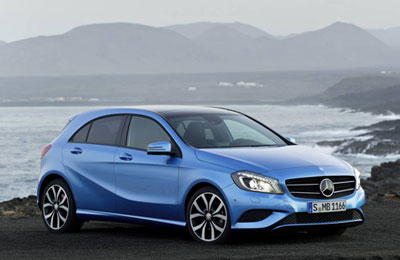
Miniature Mercedes plans 'are a risk for Daimler'
Frankfurt, April 16, 2013
Daimler could follow its high-end German competitors into the market for premium subcompact cars, but it will have to keep its costs down and volumes up to make money off any future miniature Mercedes.
The Stuttgart-based maker of luxury cars and commercial trucks has fallen far behind its two larger German premium rivals BMW and Volkswagen's Audi in terms of sales and profitability.
It has yet to launch a subcompact - a class of cars best known for mass-market models like the Volkswagen Polo, Renault Clio and Opel Corsa. Traditionally, margins in the sector have been tight and buyers motivated by value - but Audi's A1 and BMW's Mini have shown that even drivers of subcompacts will pay a premium for quality and style.
While Daimler makes the tiny Smart "microcar" - a class even smaller than a subcompact - the smallest actual Mercedes is its A-Class, a family car that competes with BMW's 1-series and Audi's A3.
A report in German weekly Focus on Sunday said Daimler was planning to position a new Mercedes model due in 2016 above the Smart, with technology to be based on the flexible A-Class architecture and with engines from French ally Renault.
A spokesman declined to comment on the Focus report but said: "We've never made a secret about the fact that every once in a while we examine whether there is room below the A-Class for another Mercedes model."
Mercedes already has its hands full this year with model launches including the new CLA four-door coupe, the flagship S-Class limousine and a major facelift of the E-Class.
At the same time, it is restructuring a weak China business, where Audi and BMW are running circles around it, while cutting $2.62 billion in costs by the end of 2014.
A drop in demand in Europe has already prompted Daimler to warn that it may lower its full-year guidance first issued in early February, when it publishes first quarter results on April 24.
The subcompact segment was the last remaining bastion untouched by German premium brands until Audi launched the A1 in 2010.
Originally investors were concerned that an Audi built off a Volkswagen Polo platform would not be embraced by upscale car owners. Moreover, it risked diluting returns, since a general rule of thumb in the industry is the smaller the car, the lower the profit margin.
But careful price positioning and a well-thought out concept that clearly differentiated the A1 from its Polo sister proved that premium no longer is a function of size.
"This is the exact same discussion we had when premium brands moved into the compact segment. The days when you could have destroyed a premium brand's image with a subcompact are over in Europe," Ulrich Winzen, chief analyst at market forecaster Polk in Germany, adding the cars themselves have grown over time anyway.
"When you look at the space in the passenger interior or measure the outer dimensions, today's small cars are roughly the same size as a compact car was 10 or 15 years ago," he added.
He estimates the market for premium subcompacts in Germany alone would grow from over 70,000 this year to more than 120,000 in five years time. Audi sold a healthy 123,000 A1's last year.
BMW has so far strictly kept the retro-styled subcompact Mini as a separate brand from its main luxury marque, but of the 300,000 Minis it sold last year, many were premium versions which can cost more than a small BMW.
There has been speculation that it could put its main brand into the sector with a new front-wheel drive subcompact, based on the Mini, that would see life as a "Zero-series" BMW.
RENAULT COULD HELP
While premium small cars have yet to take off in the United States and China - where status is defined by size - they have found their place in Europe. This is partly because companies like Mercedes need smaller cars such as the Smart in order to meet increasingly stringent EU fleet emissions targets.
"All the other segments starting from compact upwards are saturated, so I would even say it's a must for a premium carmaker," Winzen said.
Stefan Bratzel from the University of Applied Sciences in Bergisch Gladbach, expects Mercedes would need the help of its allies Renault and Nissan to create a strong enough business case for a subcompact.
"It's a very competitive market with much smaller margins so you need a very slim cost base and sell a high volume in order to be profitable. You can only realistically achieve this with a partner like Renault-Nissan," said Bratzel, who runs the Centre of Automotive Management at the university.
Daimler has plenty of liquidity to fund development. In December it reaped cash proceeds of 1.66 billion euros from the sale of half its stake in EADS, and finance chief Bodo Uebber hinted at a possible sale of the remaining 7.5 per cent sometime later this year, generating as much as 2.3 billion euros at current market prices.
Shares in Daimler fell 1.7 per cent on Monday, in line with declines among its auto industry peers. – Reuters







